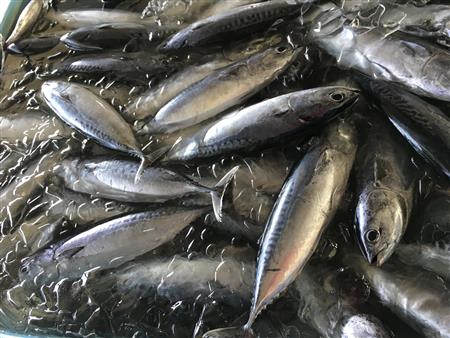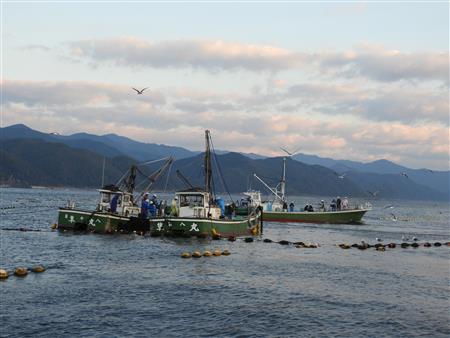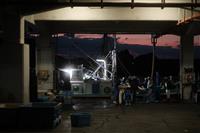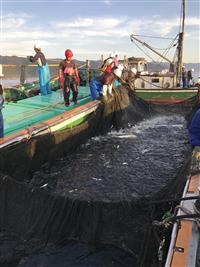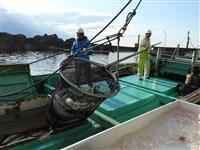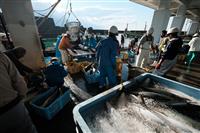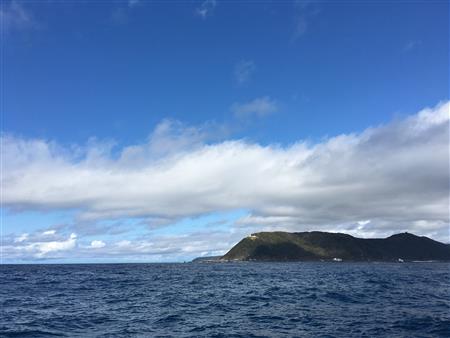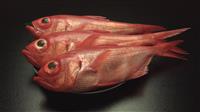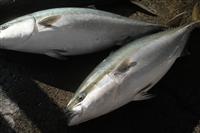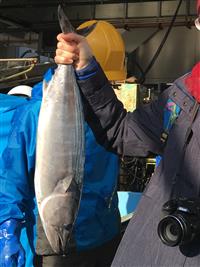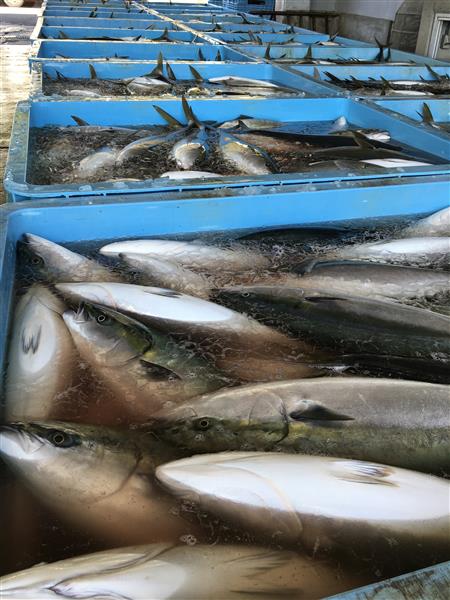Muroto's Fishing Industry
Muroto's fishing industries include fixed net fishing, kimme-dai (alfonsino) fishing, handline fishing, and coral harvesting.
The fixed fishing nets are called oshiki (大敷―the characters for large and spread) nets. There are four large oshiki nets in operation along the eastern coast of Muroto, in the Sakihama, Shiina, Mitsu, and Takaoka areas.
At the end of the 1800s Muroto's main fishing industry began to switch from whaling to fixed net fishing.
At the time, fishermen in Hokkaido used fixed net fishing to catch Pacific herring. A fisherman traveled from Muroto to Hokkaido to learn their techniques and improve the nets used in Muroto.
While the nets were improved several times throughout the years, the basis for the current style of fishing net was in use by the 1920s.
In Muroto, the fixed fishing nets are run as cooperatives, with everyone in one area working together and splitting the profits.
Fixed Net Fishing
① Preparing the Boats
Cold seawater and ice are loaded into the boat.
The ice and water keep the fish cold and fresh.
Once loaded the boats head out to the nets.
② Lifting (Holding) the Net
One large boat or three small boats work together to lift the final section of the net (where the fish are swimming).
In Muroto this is often called "holding the net."
The fish are lifted into the boat with long nets.
③ Returning to Port
The boats return to port, bringing their catch up onto land.
④ Sorting the Catch
The fish are sorted by type and size.
The species of fish vary by season.
⑤ Prices are Established
The fish are priced. They are then brought to supermarkets and fish markets where we can buy them, arriving at our tables by dinner.
Fish Directory
The Major Fish Caught in Muroto
Kimme-Dai (Alfonsino)
Kimme-dai are delicious all year round, but they are especially fatty in the spring.
They are deepwater fish, living near the bottom of the ocean.
They are a light pink when alive and turn bright red after death.
Small alfonsino are caught at around 250 meters depth off the coast of Muroto, while large alfonsino are caught at 500 meters depth.
They are caught through handline fishing or through using anchored longlines (fishing lines with multiple hooks attached to floats).
Buri (Japanese Amberjack)
This fish is called different names throughout Japan.
It also changes names depending on it's size.
In Kochi, baby Japanese amberjack are called mojyakko. As they grow they are called wakanago, hamachi, mejiro, ooio, suzuina, and finally buri.
Every December larger and rounder buri are caught in Muroto, weighing 10-13 kg. These are called kan-buri or cold buri.
Kan-buri have lots of fat, making them especially delicious and popular among the local fishermen.
Over 1000 buri can be caught in one day.
Hagatsuo (Striped Bonito)
A compact fish with large, jagged teeth.
This fish is so delicate that it must be eaten within a day of being caught. It is a delicacy that can only be eaten near its source.
Akou-Dai (Red Rock Fish)
An almost mythical fish, akou-dai used be caught in great quantities around Muroto and was sold cheaply.
They have now become a luxury food, rarely seen in stores.
The Secret to the Deliciousness of Muroto's Fish
The ocean floor drops off very suddenly off the eastern coast of Muroto. The currents in this area create an upwelling of deep seawater, rich in minerals.
Plankton feast on these minerals and in turn are eaten by fish. Many fish gather in this area making it ideal for fishing.
The fish caught in Muroto are both well-fed and extremely fresh because they are caught so close to the coast.

